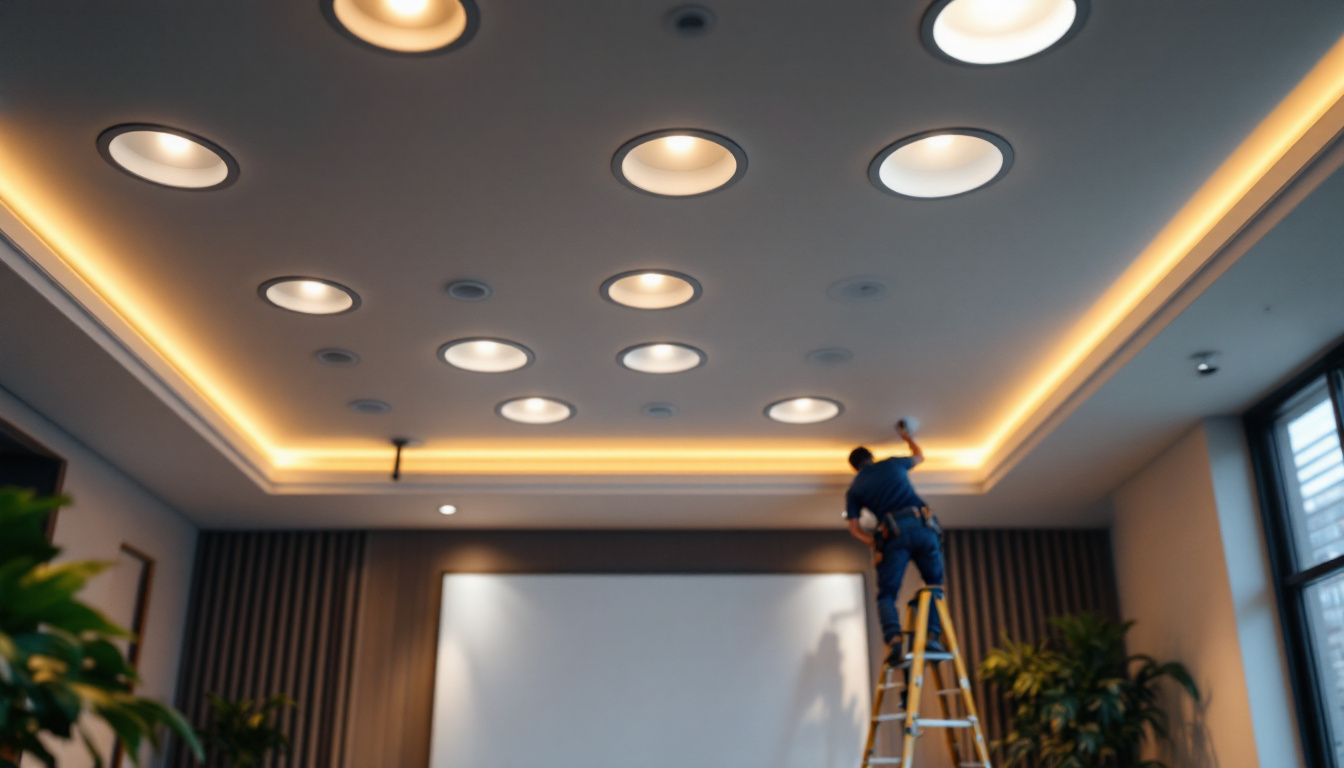
When it comes to ensuring safety in residential spaces, emergency lighting plays a crucial role. For lighting contractors, understanding the intricacies of emergency lighting installation is essential to meet safety standards and client expectations. However, even seasoned professionals can make mistakes that compromise the effectiveness of these systems. This article delves into common pitfalls encountered by lighting contractors in the realm of emergency lighting for homes, providing insights on how to avoid them.
Emergency lighting is not merely an optional enhancement; it is often a legal requirement in many jurisdictions. Familiarity with local codes and regulations is paramount for contractors to ensure compliance.
Each region may have specific codes regarding the installation and maintenance of emergency lighting systems. Failing to adhere to these regulations can lead to significant legal repercussions and safety hazards. Contractors must stay updated on local building codes and fire safety regulations, ensuring that all installations meet the required standards.
Moreover, understanding the nuances of these regulations can help contractors provide better service. For instance, knowing the minimum illumination levels required in different areas of a home can guide the selection of appropriate fixtures and their placement. This knowledge is particularly critical in high-traffic areas such as hallways and stairwells, where visibility is essential for safe evacuation during emergencies. Additionally, contractors should be aware of the testing and maintenance schedules mandated by law to ensure that emergency lighting systems remain functional and reliable.
Another common mistake is a lack of understanding of the various types of emergency lighting available. emergency lights can be categorized into several types, including battery-powered lights, self-luminous lights, and generator-powered systems. Each type has its own advantages and disadvantages, and selecting the right one for a specific application is crucial.
Contractors should assess the unique needs of each home, considering factors such as the layout, occupancy, and potential hazards. This assessment will guide the choice of lighting systems that will provide the most effective illumination during emergencies. For example, battery-powered lights are often favored for their ease of installation and independence from the building’s electrical system, making them ideal for residential settings. In contrast, generator-powered systems may be more suitable for larger commercial buildings where prolonged power outages are a concern. Understanding these distinctions allows contractors to tailor their recommendations effectively, ensuring that clients receive the best possible solutions for their specific circumstances.
The placement of emergency lights is critical to their effectiveness. Many contractors make the error of installing lights without considering the layout and design of the home.
Emergency lights should be strategically positioned to provide maximum coverage. Common areas such as hallways, stairwells, and exits must be prioritized to ensure safe evacuation during power outages or emergencies. Failing to place lights in these critical areas can result in dangerous situations where individuals may become disoriented in the dark.
Additionally, it is essential to consider the height at which lights are installed. Lights placed too high may not provide adequate illumination, while those installed too low may be obstructed. A careful assessment of the space will help determine the optimal height and positioning for emergency lights.
Another aspect often overlooked is the need for regular testing and maintenance of emergency lighting systems. It is not enough to install the lights; contractors must also educate homeowners on the importance of routine checks to ensure that the lights are functional when needed. Regular testing can identify any issues that may arise, such as dead batteries or malfunctioning bulbs.
Contractors can offer maintenance services as part of their packages, ensuring that emergency lighting systems remain operational over time. This proactive approach not only enhances safety but also builds trust with clients, showcasing the contractor’s commitment to quality and reliability.
The power source for emergency lights is a critical factor that should not be overlooked. Many contractors make the mistake of assuming that all emergency lights will function the same way under various conditions.
Battery-powered emergency lights are a popular choice, but contractors must consider the type and lifespan of the batteries used. Not all batteries are created equal; some may have a shorter lifespan or may not perform well in extreme temperatures. Choosing high-quality batteries and educating homeowners about their replacement schedules can prevent issues when the lights are needed most.
Furthermore, it is essential to consider the battery’s charging capabilities. Emergency lights should have a reliable charging mechanism to ensure they are fully operational at all times. Contractors should verify that the lights are equipped with smart charging systems that prevent overcharging and extend battery life.
For larger homes or those with specific power needs, generator-powered emergency lighting systems may be more appropriate. However, the installation of these systems requires careful planning to ensure that they are seamlessly integrated into the home’s electrical system. Contractors must assess the home’s power requirements and ensure that the generator can handle the load of the emergency lights without causing disruptions.
While functionality is paramount in emergency lighting, aesthetics should not be entirely disregarded. Many contractors focus solely on the technical aspects, overlooking how emergency lights fit into the overall design of the home.
Emergency lights should blend in with the home’s decor rather than stand out as unsightly fixtures. Contractors can offer various design options, including recessed lighting or stylish surface-mounted fixtures that complement the home’s interior. By considering aesthetics, contractors can provide solutions that enhance safety without compromising the visual appeal of the space.
Moreover, homeowners are more likely to embrace emergency lighting systems that are visually pleasing. This acceptance can lead to better maintenance and usage, as homeowners are more inclined to keep lights functional when they are integrated into their living environment.
The color temperature and brightness of emergency lights also play a significant role in their effectiveness. Harsh, overly bright lights can be disorienting, while dim lights may not provide sufficient illumination. Contractors should consider the appropriate color temperature that mimics natural light, making it easier for individuals to navigate during emergencies.
Additionally, adjustable brightness settings can enhance the usability of emergency lights. By allowing homeowners to customize the brightness based on their preferences or specific situations, contractors can provide a more versatile solution that meets various needs.
One of the most critical aspects of emergency lighting installation is ensuring that homeowners understand how to use and maintain their systems. Unfortunately, many contractors neglect this vital step, leaving clients uninformed about the proper operation of their emergency lights.
Contractors should take the time to educate homeowners about the functionality of their emergency lighting systems. Providing clear, written instructions can be beneficial, outlining how to test the lights, check battery levels, and perform routine maintenance. This information empowers homeowners to take an active role in ensuring their safety.
Additionally, contractors can offer demonstrations during the installation process. Showing homeowners how to operate the lights and perform basic maintenance tasks can enhance their confidence in using the system effectively.
Beyond installation and education, contractors can encourage homeowners to conduct regular drills to familiarize themselves with the emergency lighting system. Practicing evacuation routes and ensuring everyone knows where the emergency lights are located can significantly enhance safety during actual emergencies. These drills can also help identify any areas where additional lighting may be needed.
As families grow and change, so do their lighting needs. A common mistake made by contractors is failing to consider the potential future requirements of homeowners when installing emergency lighting systems.
Contractors should recommend scalable emergency lighting solutions that can be easily expanded or modified as the needs of the household evolve. This foresight can save homeowners time and money in the long run, as they won’t need to replace the entire system when additional lighting is required.
For instance, if a family plans to add a basement or expand their living space, contractors can suggest systems that allow for easy integration of new lights without extensive rewiring or installation processes.
Staying abreast of technological advancements in emergency lighting is also essential. Smart emergency lighting systems that can be controlled via mobile apps or integrated with home automation systems are becoming increasingly popular. Contractors should be knowledgeable about these innovations and offer them as options to clients looking for modern solutions.
Emergency lighting is a critical component of home safety, and lighting contractors play a vital role in ensuring these systems are installed effectively. By avoiding common mistakes such as neglecting regulatory compliance, improper placement, and overlooking user education, contractors can provide high-quality emergency lighting solutions that enhance safety and peace of mind for homeowners.
Ultimately, a thorough understanding of emergency lighting requirements, careful planning, and a commitment to ongoing education will help contractors deliver exceptional service. By prioritizing both functionality and aesthetics, contractors can create emergency lighting systems that not only meet safety standards but also integrate seamlessly into the home environment.
In an ever-evolving field, staying informed about the latest trends and technologies will further enhance the contractor’s ability to serve their clients effectively. With these insights, lighting contractors can position themselves as trusted experts in emergency lighting solutions, ensuring that homes remain safe and well-lit in times of need.
Ready to elevate your emergency lighting installations with the highest quality products? Look no further than LumenWholesale. Our extensive selection of spec-grade lighting solutions meets rigorous industry standards, ensuring your projects shine with reliability and performance. Say goodbye to inflated markups and hello to unbeatable wholesale prices, plus enjoy the convenience of free shipping on bulk orders. Don’t compromise on quality or value—visit LumenWholesale today and discover the perfect blend of affordability and excellence for all your lighting needs.

Explore the pros and cons of Fixture Led lighting compared to other alternatives in this insightful guide for lighting contractors.

Discover why purchasing wafer lighting in bulk from local distributors might not be your best bet.

Discover how stair lighting is revolutionizing the lighting industry with innovative designs and enhanced safety features.

Discover the essential guide to 2-inch recessed lights tailored for lighting contractors.